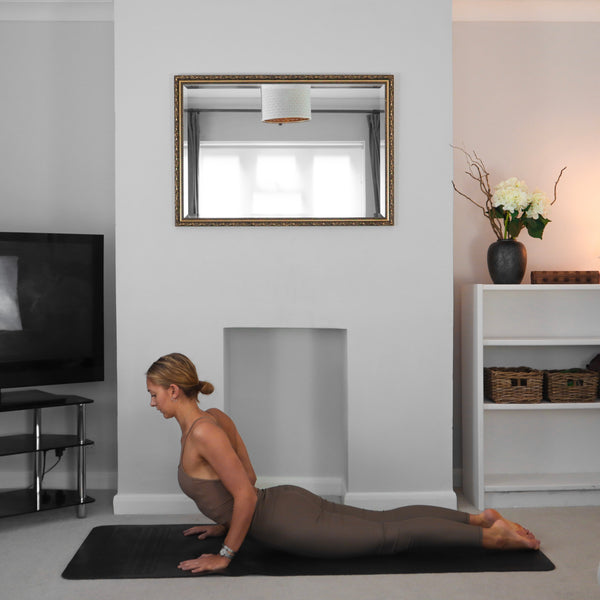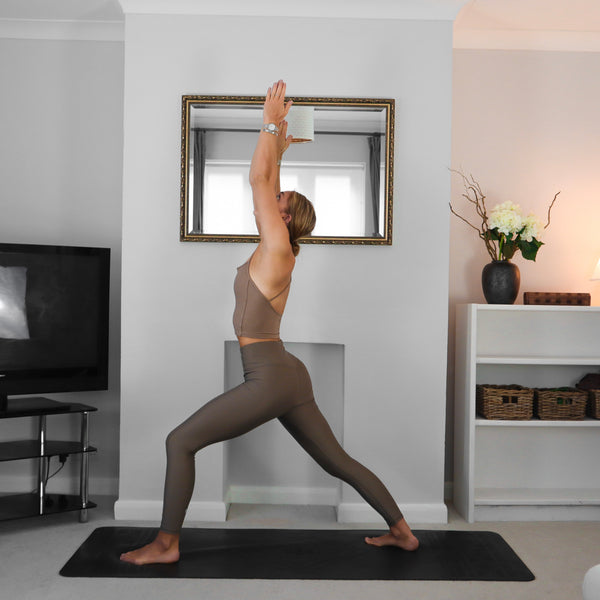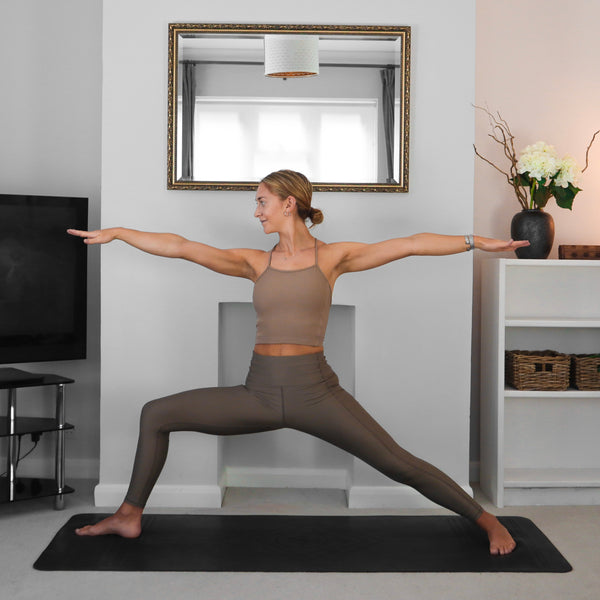If life’s got you feeling as worn out as the rest of us right now, we’ve got some good news. You don’t need to own a single inch of lycra, spend a single penny, or even have stepped foot inside a studio in order to enjoy the benefits of yoga. With its ability to calm the mind, strengthen muscles, and improve flexibility, it’s a practice that everyone can benefit from, no matter your experience.
Not sure where to start? We’ve put together a list of eight of our favourite yoga poses that are perfect for beginners looking to try their hand at this incredible practice. Try them in a sequence (moving from one straight into the next) for a quick and easy - but super beneficial - mini-flow.
Mountain
Yes, really, this is a yoga pose – and one of the most important! This is how many yoga practices will begin, and while it may seem almost too simple to ‘count’ as yoga, there’s actually a lot going on. Mountain pose is super important for allowing your feet to connect with the ground, finding presence in your body, and enabling you to achieve stability and stillness at the beginning of a session.

How to do it: Plant both feet flat on the ground, and hold your spine straight, engaging the core. Have your toes slightly spread and pushing into the ground, to allow yourself to be fully stable. Keep your weight distributed evenly across both feet and have your arms hanging by your sides with your palms facing forward or raise them into a prayer position. Keep your shoulders down and relaxed, and your chin slightly raised.
Cobra
Great for your core, cobra pose is a sure-fire way to stretch out the abdomen and improve mobility and strength in the vertebral column, in turn improving flexibility and balance.

How to do it: Lie on the ground face down. Place your palms on the ground underneath your shoulders, and push up slightly so that your back arches off the floor. Keep your elbows pressed tightly against your body and look straight ahead with your chin slightly raised. Push up with your arms as far as you can with your hip bones still touching the ground. Keep your shoulders pressed down, your chest pushed out, and breathe steadily.
Downward Dog
If you’ve heard of any yoga pose before, it’s probably this one. Downward dog is used in nearly all yoga practices, given its ability to offer a full body stretch, while also balancing the body and allowing for some amazing deep breathing.

How to do it: Start on your hands and knees, with your toes tucked under your feet. Have your knees slightly apart in line with your hips and your hands underneath your shoulders, fingers splayed.
Lift your tailbone up towards the ceiling. You can have your legs slightly bent or straight. Try to keep your back flat with your head between your arms, eyes looking to your legs. Breathe in through your nose and out through your mouth steadily.
Warrior 1
Warrior 1 is a powerful pose which tests balance and concentration while strengthening the back and lower body. Move slowly to allow your mind to focus and your breathing to remain steady.

How to do it: Starting from Mountain Pose, step your left foot back and bend your right leg, so you're in a lunge position. Then turn your left foot about 45 degrees to the left, so it's pointing outwards. Keep your right foot facing forward. With your arms held out parallel in front of you, sweep them upwards until your fingers are pointing towards the sky. Keep your hips parallel, facing forward. Keep your chin raised and hold the position, pushing both feet down into the floor. Repeat on both sides.
Warrior 2
Very similar to Warrior 1, Warrior 2 is a common next step in many flows which combine the two.

How to do it: From Warrior 1 (with your right foot forward), bring your arms down from above your head so that they're parallel to the ground, right arm in front of you above right leg and left arm behind you above your left leg. Turn your body to face outwards to your left, but keep your head facing forward. Repeat on both sides.
Triangle
Triangle pose strengthens the legs and core, as well as challenging and improving flexibility and balance. It’s a great move to add in to a flow after Warrior 2, as your legs and feet are already in position.

How to do it: From Warrior 2, straighten your front leg so that your legs make a triangle with the ground. Bring your front arm forward and down, reaching towards your front foot. If you can, bring your hand all the way down to rest on your foot – if you’re not quite there yet, rest it as far down your front leg as you can.
Bring your other arm up so that it’s pointing straight towards the sky, perpendicular to the floor. Keep your chest open and turn your head up so that you're looking up towards your fingertips. Breathe steadily. Repeat on both sides.
Tree
A great introduction to more difficult balancing poses, the tree pose requires a clear mind and plenty of focus to ensure your body stays upright. This pose is perfect for strengthening the legs and core as your body works to find stillness.

How to do it: Starting in Mountain Pose, press your palms together in front of your chest in a prayer position, and bring your left foot slowly up your right leg until it reaches just above the knee (or just below if this is too difficult). Rest it on your leg and press into your inner thigh or knee to help you balance. Move your arms upwards until they are straight above your head. Hold your spine straight and have your chin slightly raised. Focus your eyes on a still point to help you balance. Repeat on both sides.
Child’s Pose
A great way to end a session, child’s pose draws out the spine and stretches internal organs, as well as allowing the body to relax and your mind to focus.

How to do it: Kneel on the floor with your feet tucked underneath you. Slowly bring your body down so that you’re sitting on your feet. Then bend forwards with your arms straight, until your chest is touching your thighs and your arms are stretched out along the floor. You can keep your knees slightly apart if this is easier. Keep both palms flat on the ground.
So now you’re equipped with a handful of yoga poses that should have you well on your way to becoming more flexible, supple, centred and relaxed. Try out each of them when you wake up or before bed, or incorporate them into your very own yoga flow (you can find tons of choices on YouTube) and be sure to keep us updated on your results!
Images: Georgia Sugg (@suggyoga).


















